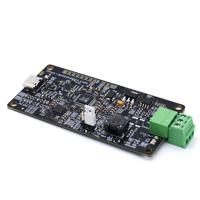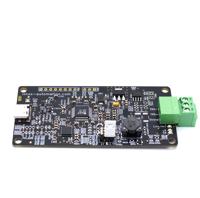USB-T1L
The USB-T1L is a development tool for the relatively recent 10Base-T1L ethernet standard, which is intended to be used in industrial and automotive settings.
Especially in the industrial setting 10Base-T1L is intended to replace analog 4..20 mA interfaces and CAN-busses with industrial Ethernet on a two-wire twisted pair.
10Base-T1L has a couple of benefits, among which are the reduced wiring complexity, due to T1L only requiring a single pair of twisted wires, low power requirements and the possibility of very long cable runs of up to 1km. The tradeoff 10Base-T1L does for these great benefits is the relatively low maximum data rate of 10Mbit/s.
Typical Applications
Adding a 10Base-T1L interface early in the development of an embedded Linux application
With the USB-T1L a 10Base-T1L interface can be added to every Eval Board with USB. Through the available circuit diagram, as well as the existing mainline Linux support integration into existing designs is easy. The USB-T1L allows direct accesses to the registers of the TI DP83TD510E 10Base-T1L Phy, thus the integration of the USB-T1L is comparable to the later design.
Use as known remote station
The USB-T1L can be connected directly to a notebook or test server via the USB interface. This allows the simple use as known remote station.
Special Properties
Connector
There are currently two competing standards when it comes to industrial ethernet T1L connectors. In order to be neutral, the T1L comes with a screw terminal to connect the 10Base-T1L cable pair.
Access to the registers of the PHY
The USB-T1L is built in a way, that gives the Linux kernel complete and native access to the registers of the 10Base-T1L phy. This means that the USB-T1L does not require any firmware on the device or vendor software on the host. All aspects of the phy can be controlled using standard Linux tools.
USB to RMII interface
The widely used Asix AX88772 is used as the USB-to-RMII interface.
10Base-T1L signalling level and couping
The signal amplitude can be preset to 1 Vpp or 2.4 Vpp by a jumper. The necessary positions for an intrinsic-safe coupling network are available and can be placed if required.
Unique MAC address
The device ships configured with a unique MAC address.
Our Commitment to Quality
This device is manufactured in Germany. Each device is put into operation and tested by hand by Linux Automation.
Support in Linux Distributions
The following list gives an overview on upstream support in different Linux distributions:
- Linux Kernel: Module DP83TD510_PHY is part of Linux since 6.1.
- Debian: The module is part of the Kernel since Linux 6.6.3-1_exp1 and should be part of Debian 13. It is also available in Debian 12 backports.
- Raspbian: The module is currently not activated. You will need to compile your own kernel.
Resources
| Shop: | https://shop.linux-automation.com/Test-Automation/usbt1l-en |
| Datasheet: | datasheet_usb-t1l-R05.pdf |
| Schematic: | usbt1-S01_USB_T1L.pdf |
| Assembly: | Assembly-front.pdf, Assembly-back.pdf, Interactive BOM |



